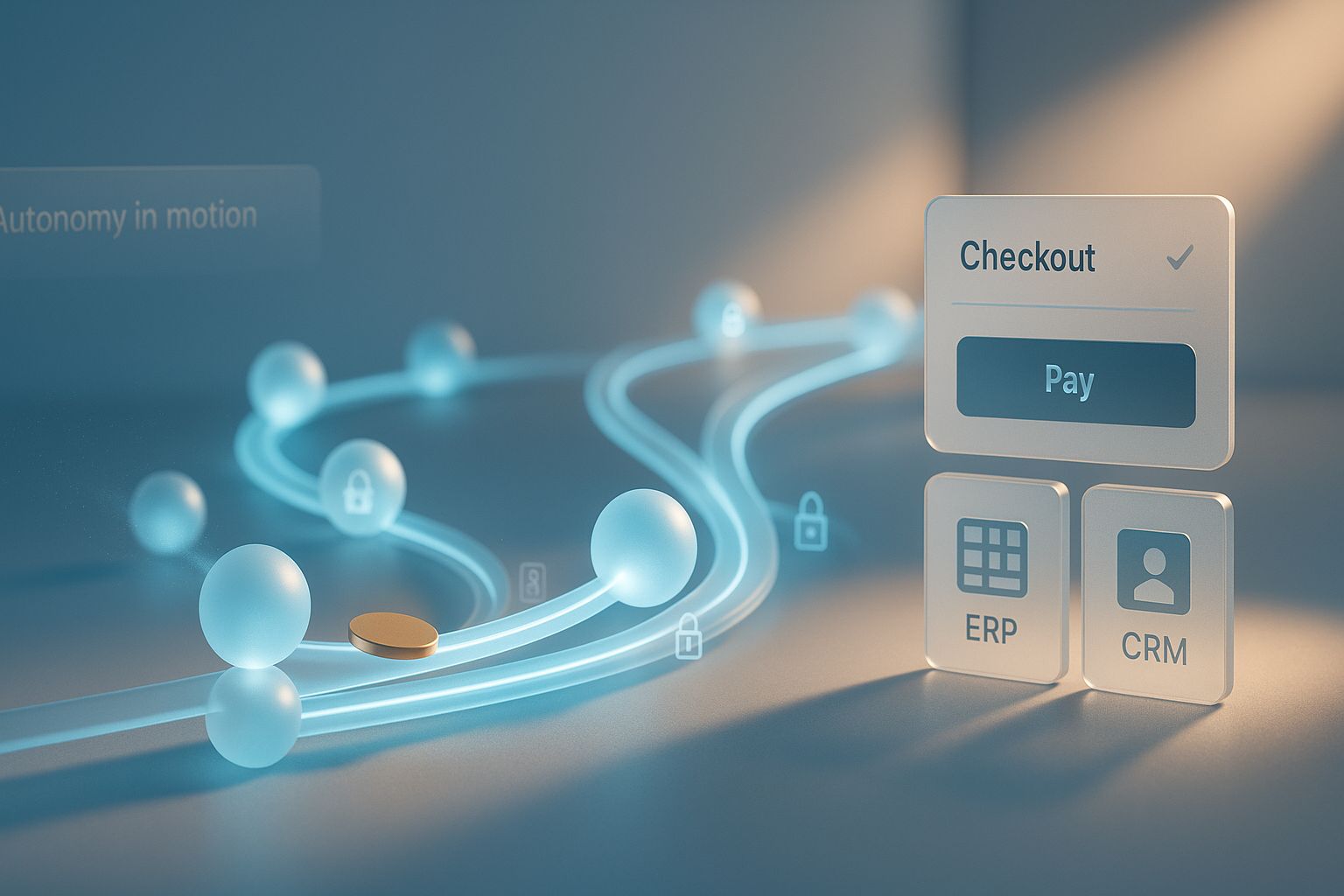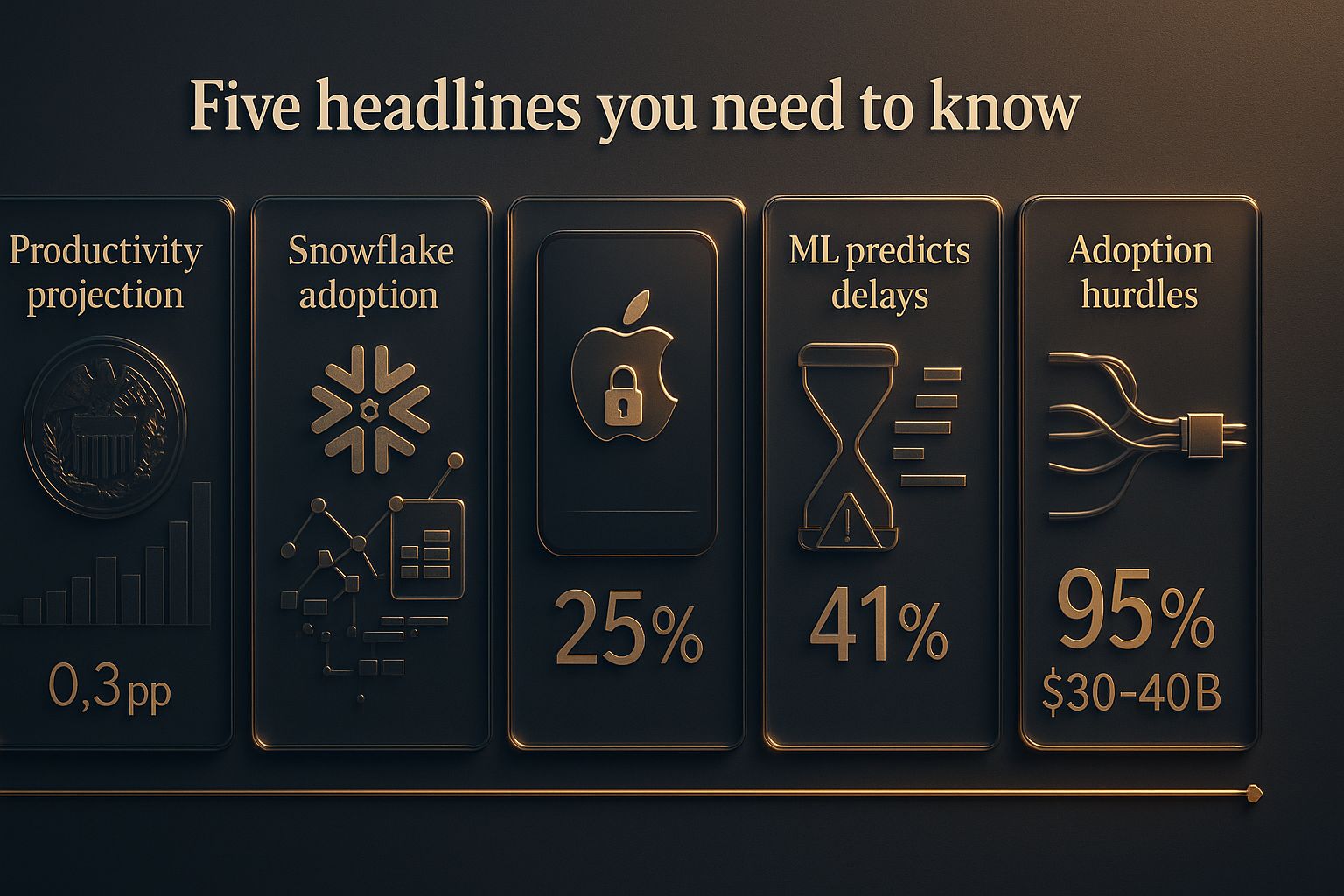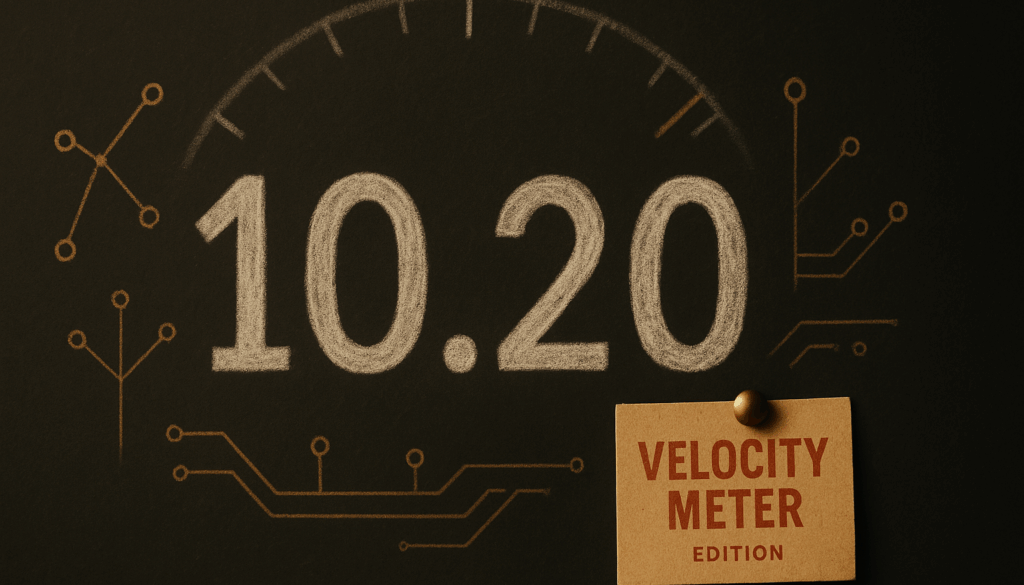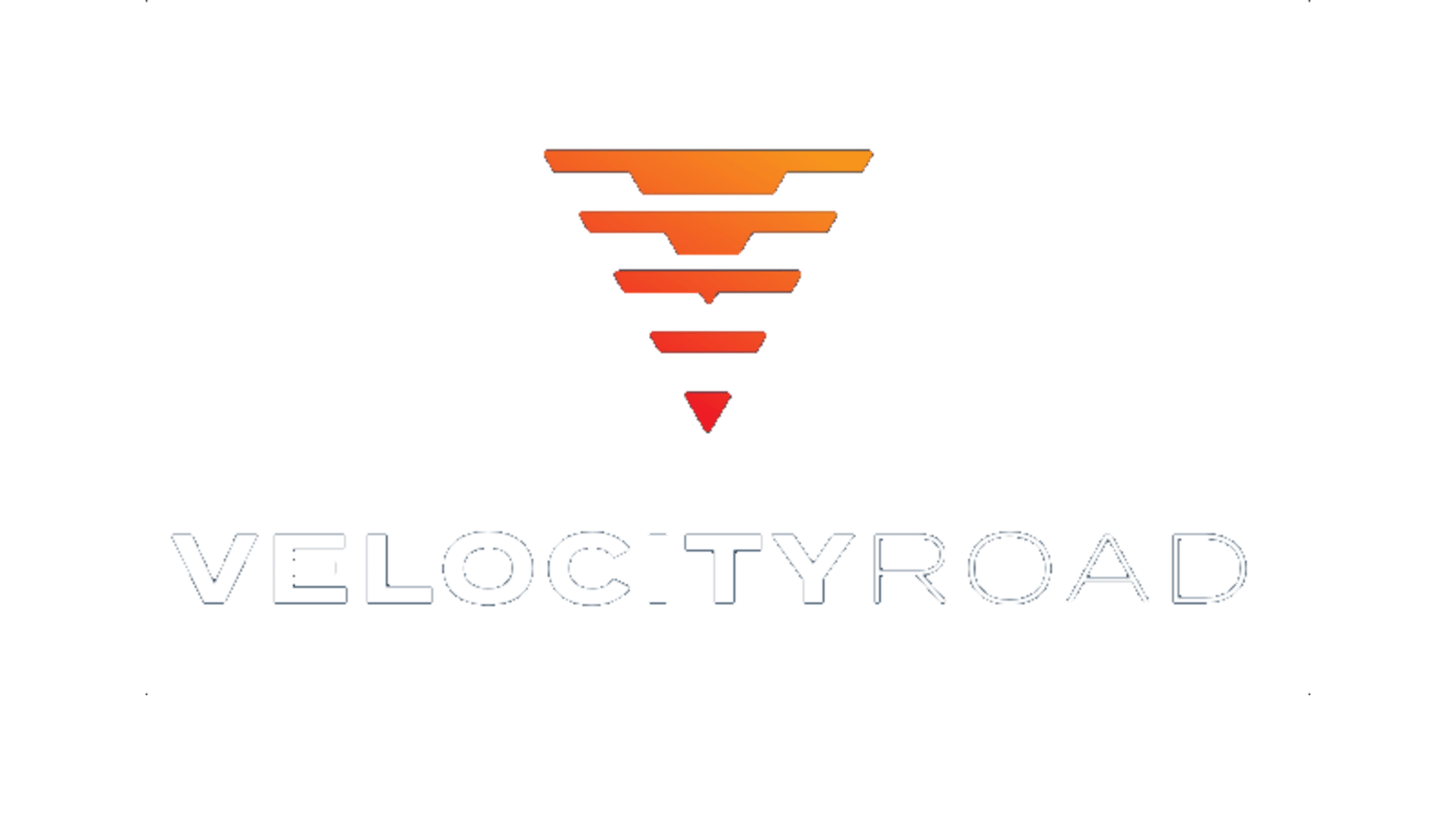From Copilot to Colleague: How Agentic AI Is Rewriting the Rules of Business
🤝 From Copilot to Colleague: How Agentic AI Is Rewriting the Rules of Business
The AI conversation has shifted. We're no longer talking about tools that respond to commands—we're building systems that initiate action, orchestrate workflows, and transact on our behalf.
Agentic commerce could generate up to $1 trillion in the US B2C retail market alone by 2030, with global projections reaching $3-5 trillion. Visa has launched its Trusted Agent Protocol to distinguish legitimate AI shopping agents from bots, while Walmart and OpenAI are integrating ChatGPT for meal planning, restocking, and checkout—all in a single conversational flow.
This isn't incremental improvement. Agentic AI represents a fundamental shift from intelligence that assists to intelligence that acts—autonomously making decisions, negotiating transactions, and optimizing business processes without human intervention at every step. BCG research shows these agents can accelerate business processes by 30-50%, reduce human error, and cut low-value work time by 25-40%.
But autonomy introduces complexity. These agents don't just execute tasks—they reason, adapt, and interact across systems. Success requires rethinking everything from identity management to business models, from workflow architecture to competitive strategy. The companies that master this transition won't just improve efficiency. They'll fundamentally redefine how value is created and captured in their industries.
Let's dive in.

🎯 The Agent Economy: When AI Stops Assisting and Starts Transacting

For two years, we've been conditioned to think of AI as a helpful assistant—a smarter search engine, a faster copywriter, a pattern-recognition tool that makes humans more productive. That framing is now obsolete.
Agentic AI moves us toward a world where AI anticipates consumer needs, navigates shopping options, negotiates deals, and executes transactions—all in alignment with human intent yet acting independently through multistep chains of actions. This isn't evolution. It's a rethinking of commerce itself, where boundaries between platforms, services, and experiences give way to integrated, intent-driven flows.
Consider what's already happening. Walmart's partnership with OpenAI enables customers to prompt ChatGPT with "plan a weeknight taco dinner" and receive curated product picks with instant checkout—collapsing what used to be search, comparison, selection, and transaction into a single conversational step. Visa's Trusted Agent Protocol, developed with Cloudflare and partners including Microsoft and Shopify, creates the infrastructure for AI agents to shop safely while merchants maintain control and security.
The technical enablers are proliferating: Anthropic's Model Context Protocol (MCP), Agent-to-Agent (A2A) Protocol, Agent Payments Protocol (AP2), and Agentic Commerce Protocol (ACP) are establishing standards for how autonomous agents communicate, transact, and coordinate across platforms. These aren't theoretical specifications—they're production frameworks enabling a new era of intelligent, autonomous commerce.
From Workflow Automation to Workflow Orchestration
BCG research distinguishes between traditional automation and agentic AI along critical dimensions. Traditional automation focuses on efficiency through predefined rules and sequential processes. Agentic AI brings intelligence, adaptability, and continuous learning—taking autonomous, goal-directed actions and processing workflows at unprecedented speed without latency.
The implications extend across the enterprise:
Workflow orchestration in ERP/CRM platforms: AI agents auto-resolve IT service tickets, reroute supplies to cover inventory shortages, and trigger procurement flows without human input. Early adopters see 20-30% faster workflow cycles and significant back-office cost reductions.
Customer service transformation: Agents handle insurance claims end-to-end—document validation, triage, escalation, and payout—cutting handling time by 40% in some instances while increasing net promoter scores by 15 points.
Sales and marketing automation: AI-driven campaign managers test, adapt, and optimize consumer touchpoints in real time. One B2B SaaS firm experienced 25% lead conversion increases after implementing agentic campaign routing.
Salesforce's Agentforce has captured 38% market share in deployment methods, while ServiceNow's AI agents and Now Assist capabilities automate IT, HR, and operational processes, reducing manual workloads by up to 60%.
The Marketing Frontier: When Agents Become Strategists
The most provocative application may be in marketing itself. By 2030, performance marketing could feature AI agents that don't just optimize campaigns but run them autonomously—making strategic decisions about channel allocation, creative testing, and budget reallocation without human oversight.
This agent-driven future raises fundamental questions: How do agents learn a marketer's decision-making style? Through training on past campaigns, action history, performance reports, and strategic preferences. The result: digital twins that optimize like you would, but faster and at scale.
Agents can collaborate through Agent2Agent (A2A) protocol, sharing expertise across specializations. An agent strong in ecommerce campaigns can request help from a B2B specialist, creating a network effect where collective intelligence grows continuously. Using Agent Payments Protocol (AP2), agents can even monetize expertise—charging other agents for access to proven optimization strategies.
The Governance Imperative
This power demands corresponding safeguards. BCG outlines critical controls across the AI agent lifecycle:
Design phase: Create secure-by-design concepts with explicit ownership, least-privilege access, clear autonomy thresholds, and hard ethical boundaries. Every agent needs a defined owner, role-based access, risk tiering with spending caps, and permanent blocks on actions that violate company values.
Build phase: Turn requirements into engineering through guardrails, sandboxing, rigorous validation, and kill switches. Wrap every action in strict schemas with "allow" lists, input checks, timeouts, and spending caps to stop risky transactions before they occur.
Operate phase: Run agents as products with empowered human oversight, comprehensive logging for auditability, and disciplined change management. Every decision must be traceable, every update version-controlled, with shadow rollouts enabling safe testing before wide deployment.
Without these controls, agentic AI creates cascading risks—expanded attack surfaces for cybersecurity threats, potential bias amplification, and governance failures where well-constructed agents go off course without oversight.
The Strategic Inflection Point
McKinsey frames the choice starkly: Agentic AI isn't optional—it's existential. Companies that adapt quickly will redefine their industries. Those that hesitate risk losing ground as AI agents become the new gatekeepers of commerce.
The agenda for CEOs includes:
Recalibrating knowledge work: As AI grasps judgment, multistep reasoning, and problem-solving, rethink roles and structures for ethical, effective human-AI collaboration
Redefining competitive advantages: As costs drop and capabilities rise, focus on true differentiators—data, technology, culture, and enterprise-wide capabilities
Reimagining value creation: Think beyond short-term productivity to transform customer experience, spark innovation, and deliver sustained value
Embedding AI into high-value domains: Stop deploying tools and disjointed pilots. Start thinking "AI inside" where AI is embedded into workflows and processes are rewired end to end
The limiting factor is no longer technology's capabilities but humans' ability to oversee and manage agents effectively.
📌 Bottom Line: Agentic AI transforms AI from assistant to actor—autonomously executing multistep processes, transacting across systems, and optimizing at machine speed. The transition requires technical enablers (protocols, infrastructure, governance) and strategic rethinking (business models, workflows, competitive positioning). Organizations that master both will capture disproportionate value. Those that don't will find themselves competing in markets where AI agents, not humans, make the buying decisions.

🏭 AI Across Industries

🏥 Healthcare: Agents Move from Lab to Clinic
Healthcare's agentic transformation is happening faster than anticipated. 74% of health executives report positive ROI from AI deployments, with production-ready systems now handling clinical workflows that seemed theoretical months ago.
Google Cloud and healthcare partners announced production deployments including clinical-note summarization at scale at Hackensack Meridian Health, a public breast-cancer screening assistant from Color Health, a multi-agent prior-authorization platform from IKS Health, and a "self-driving" real-world evidence system from Castor—all running on Google Cloud with Gemini model integration.
The results demonstrate operational viability. 62% of healthcare and life-sciences organizations have moved use cases into production, with 80% reaching production within six months. Among those with production systems, 63% report revenue increases alongside 74% reporting positive ROI.
McKinsey estimates 50-75% of manual prior authorization steps are automatable. But production agents must show payer-verified first-pass approvals, shorter appeal cycles, and fewer denials—quantified with synchronized agent logs and payer timestamps.
📌 Takeaway: Healthcare's agentic AI success stems from focusing on measurable workflow improvements rather than technology capabilities. Agents handling screening coordination, prior authorization, and clinical documentation demonstrate that autonomy works when paired with clear accountability and verification protocols.
💼 Financial Services: Trust Meets Automation
Anthropic and Salesforce expanded their partnership to make Claude a preferred model for Agentforce, specifically targeting regulated industries including financial services, healthcare, cybersecurity, and life sciences. The integration keeps all Claude traffic within the Salesforce virtual private cloud, making Anthropic the first LLM provider fully integrated within the Salesforce trust boundary.
RBC Wealth Management uses Claude in Agentforce to help advisors with meeting preparation—their most time-consuming task. The system provides automated briefings that save significant time, allowing advisors to focus on client relationships rather than information gathering.
The partnership extends to industry-specific solutions. Claude for Financial Services integrates with Salesforce's Agentforce Financial Services, enabling AI agents to better understand financial instruments, insurance claims, and industry frameworks with deep domain expertise these sectors require.
Example workflow: A financial advisor uses Agentforce powered by Claude to summarize client portfolios, flag new industry requirements affecting retirement plans, and automate consent tracking and customer outreach. The agent securely combines CRM insights with latest industry updates to deliver compliance-ready action plans—turning hours of work into a single, trusted workflow.
📌 Takeaway: Financial services adoption of agentic AI hinges on trust boundaries and domain expertise. Success requires AI that operates within existing governance frameworks while delivering the deep sector knowledge that human advisors currently provide manually.
🛒 Retail: From Search to Conversation
Target's implementation of generative AI spans merchandise development and third-party marketplace management, demonstrating how agents reshape core business functions.
Target Trend Brain, their generative AI-powered trend intelligence platform, merges merchant creativity with AI-driven efficiency to accelerate product development. Rather than replacing designers, the system empowers creativity with the agility of AI—designers make decisions, AI provides speed and ideation support.
For Target Plus marketplace, agentic AI now reviews seller applications, analyzing online information to summarize applications for marketplace analysts. This enables Target to maintain its "thoughtfully selected" curation at scale.
The retailer rolled out demand forecasting across categories for holiday 2025, with predictions improving with every iteration. CIO Prat Vemana expects AI-powered positioning and placement to significantly reduce customer frustration.
Critical to adoption: Target deployed over 10,000 new AI licenses since Q1 earnings and partnered with OpenAI to train staff, building workforce AI fluency organization-wide.
📌 Takeaway: Retail's agentic success requires balancing automation with human judgment—using AI for ideation, analysis, and forecasting while preserving human decision-making on creative and strategic dimensions. The model-agnostic approach allows experimentation without vendor lock-in.
💳 Payments: Building the Agent Infrastructure
Visa's Trusted Agent Protocol, developed with Cloudflare and supported by Microsoft, Shopify, and Adyen, addresses a critical infrastructure need: how merchants distinguish legitimate AI shopping agents from malicious bots.
The protocol responds to a 4,700% year-over-year increase in AI-driven shopping activity, according to Visa data. Without standards, merchants face an impossible choice: block all automated traffic (losing legitimate agent transactions) or accept the risk (exposing systems to bot attacks).
The system is designed to make AI-driven shopping as seamless as today's online checkout without forcing merchants to overhaul systems. Agents and merchants exchange data with clear certification that confirms "this isn't a bot—this is a registered and certified agent."
Visa's Chief Product and Strategy Officer Jack Forestell predicts 2026 could mark the first real season of agentic shopping, when a measurable share of purchases actually happen via AI agents rather than agents simply assisting with research while humans complete transactions.
📌 Takeaway: Agentic commerce requires new infrastructure layers that balance autonomy with security. Payment networks creating protocols for agent verification enable the broader ecosystem to deploy agents confidently, knowing transactions are authenticated and traceable.

📊 AI by the Numbers

📈 30-50% acceleration in business processes from effective AI agents across finance, procurement, and customer operations, alongside 25-40% reductions in low-value work time and error minimization (BCG)
🏥 74% of healthcare and life-sciences executives with deployed generative AI report positive ROI on at least one use case, with 62% having moved use cases into production (Google Cloud Survey)
💰 $3-5 trillion in global value projected from agentic commerce by 2030, including up to $1 trillion in the US B2C retail market alone as AI agents fundamentally reshape shopping and transactions (McKinsey)
🤖 98% of Morgan Stanley wealth management advisors actively use the firm's AI chatbot for rapid access to intellectual capital, with productivity gains measured across all segments of the wealth management business (Morgan Stanley)
📊 4,700% year-over-year increase in AI-driven shopping activity according to Visa data, driving the need for Trusted Agent Protocol infrastructure to distinguish legitimate agents from malicious bots (Visa)

📰 Five Headlines You Need to Know

🔬 Dallas Fed: AI Could Boost Productivity Growth 0.3 Percentage Points Annually
Federal Reserve economists project AI could add 0.3 percentage points to annual productivity growth over the next decade—the low end of Goldman Sachs estimates ranging from 0.3 to 3.0 points. While modest compared to extreme singularity scenarios, this represents meaningful economic impact: a few thousand dollars difference in GDP per capita by 2050. The research emphasizes AI's potential to reverse disappointing post-2008 productivity trends by lowering the cost of idea discovery and accelerating innovation. Notable validation: half the 2024 Nobel Prize in chemistry went to DeepMind researchers for AI-based protein structure prediction, demonstrating AI's capacity to accelerate scientific discovery.
🏢 Snowflake's AI Council: 90% Marketing Team Adoption Through Structured Innovation
Snowflake achieved 90% AI adoption across its 450-person marketing organization through an AI council structure—30 naturally curious people spending 20% time exploring AI possibilities for their functions. Rather than asking all marketers to experiment (creating chaos), the council tests tools, attends conferences, and holds quarterly "AI Days" to roll out findings organization-wide. Critical proprietary agents include a campaign agent providing real-time ROI data and optimizing digital ad spend, and a competitive intelligence agent giving sales teams instant, customized talking points for any compete situation. The approach: invest in readiness (literacy, governance, talent) rather than just technology.
🛡️ Apple's Privacy-First AI Approach Drives 25% Stock Surge
Apple's on-device processing and differential privacy approach to Apple Intelligence contributed to a 25% stock surge following WWDC 2024 announcements. The company's ~3 billion parameter on-device language model processes AI features locally, with Private Cloud Compute extending device-level security to cloud processing. This privacy-by-design approach demonstrates that security and functionality can coexist profitably—directly addressing the enterprise concern that AI deployment inevitably compromises data protection. The model proves competitive advantage can be built on trust rather than requiring trade-offs between capability and security.
🎯 Machine Learning Predicts 41% of Project Delays Before They Happen
Analysis of 5,000 Jira tickets using Random Forest modeling successfully identified 41% of delayed tickets before they impacted timelines. The model identified complexity per person and priority-story points interaction as strongest prediction drivers, enabling project managers to focus on the riskiest 20% of tasks that drive roughly 10% of total project delays. By applying preventive actions to these high-risk tickets, the analysis estimates potential savings of $9,270 (nearly 10% of total project cost) on a medium-size $100,000 project. The research demonstrates how data science augments rather than replaces project management expertise, providing early warning systems that enable proactive intervention.
🔐 Enterprise AI Adoption Hindered by Data Quality and Skills Gaps
Despite enterprises investing $30-40 billion in generative AI, 95% of pilot programs fail to achieve measurable profit and revenue impact. Key barriers include lack of strategic vision (initiatives treated as "shiny new things" rather than integrated digital transformation), data quality issues (siloed, unstructured data preventing AI from functioning effectively), and skills shortages (fear of replacement creating cultural resistance). Success cases like Unilever's 41% productivity boost and Starbucks' near-50% revenue from AI-powered recommendations share common patterns: business-aligned strategy from day one, investment in data infrastructure and governance, dedicated upskilling programs, and phased approaches starting with high-impact use cases before scaling.

🎯 Final Take: The Business Case for Agents

The shift from AI as tool to AI as autonomous actor isn't distant future—it's operational present. Nearly three in four healthcare executives report ROI. Ninety percent of Snowflake's marketing organization uses AI daily. BCG clients see 30-50% process acceleration. McKinsey projects $3-5 trillion in global agentic commerce value by 2030.
But autonomy without governance creates risk. The organizations succeeding share patterns: they build literacy before scaling deployment, establish clear ownership and accountability for every agent, implement comprehensive logging and auditability, create governance frameworks that enable rather than constrain innovation, and design hybrid models where AI handles orchestration while humans provide judgment.
McKinsey's research is unambiguous: This transformation demands new leadership—bold, adaptive, unafraid to challenge the status quo. The questions aren't academic; they're existential, not just for organizations but for society.
The future of business isn't human or AI. It's both, working in concert, with clear roles: AI for speed, scale, and optimization; humans for strategy, judgment, and accountability. Organizations that crack this hybrid model don't just improve efficiency. They redefine competitive advantage in their industries.
The agent economy is here. The question is whether your organization is ready to participate in it—or will watch from the sidelines as others capture the value.
📩 Ready to Build Your Agentic Strategy?
🎯 At Velocity Road, we help mid-market companies operationalize agentic AI through strategic planning, implementation frameworks, and organizational readiness assessment. We don't sell tools—we build the capabilities that make any tool work better.
Let's discuss how we can accelerate your AI transformation—schedule a consultation today.
📬 Forward this newsletter to colleagues who need to understand AI's production reality. And if you're not subscribed yet, join thousands of executives getting weekly intelligence on AI's business impact.




